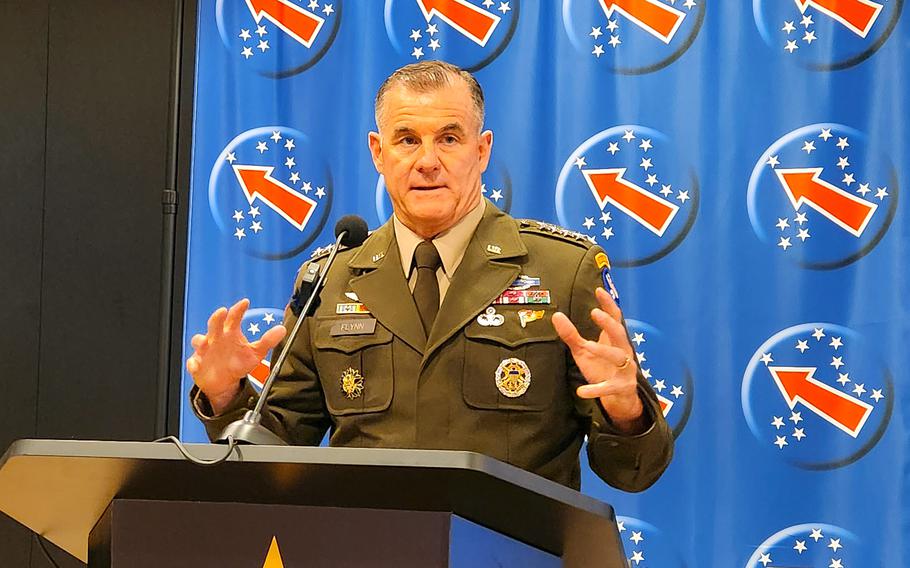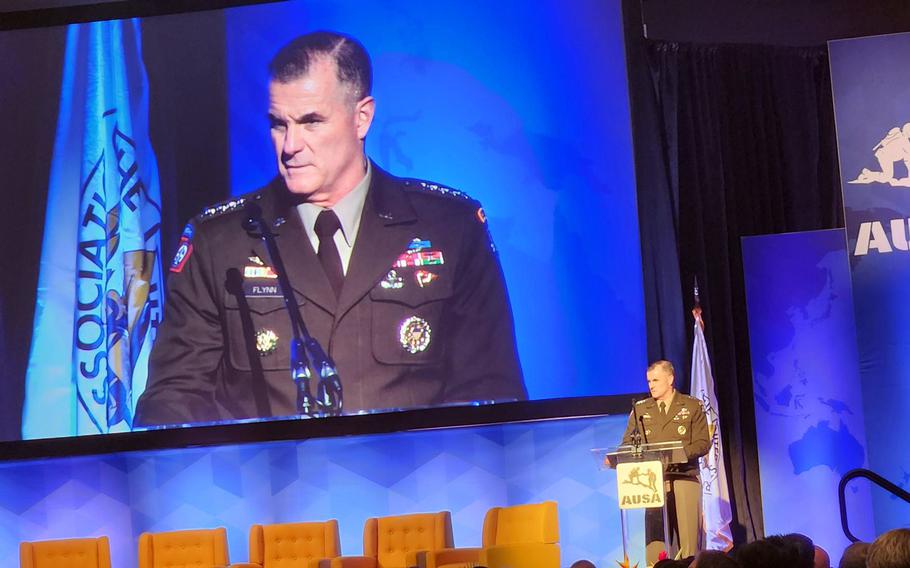
Gen. Charles Flynn, commander of U.S. Army Pacific, speaks to reporters during a news conference at the LANPAC Symposium on Waikiki Beach, Hawaii, May 14, 2024. (Wyatt Olson/Stars and Stripes)
HONOLULU — The commanding general of U.S. Army Pacific stood before hundreds of soldiers from armed forces around the region Tuesday and continually returned to one topic: peace.
“Through our unity and collective commitment to each other, we must achieve a lasting peace,” Gen. Charles Flynn said during the keynote speech kicking off the three-day Land Forces Pacific, or LANPAC, symposium on Waikiki Beach.
“And we’ll do so by mobilizing the collective capabilities and strengths of our strategic land power network,” he said. “We have to make the sum greater than its parts. Mobilizing our strategic land power network for the greater good is vital to our security and prosperity for each of our nations and for the region.”
The annual international symposium in Hawaii, organized by the Association of the U.S. Army, focuses on the role and use of land forces in the Indo-Pacific region.
As head of U.S. Army Pacific, Flynn oversees about 107,000 soldiers and civilian workers stationed over a vast area that includes Alaska, Hawaii, Japan, South Korea, Guam, American Samoa and Saipan.
The importance of land forces has been a central topic in most of Flynn’s public speaking engagements since he took command of Army Pacific three years ago.

Gen. Charles Flynn, commander of U.S. Army Pacific, addresses the audience at the LANPAC Symposium on Waikiki Beach, Hawaii, May 14, 2024. (Wyatt Olson/Stars and Stripes)
“Well, just to beat that drum once more, here’s my view,” he said. “Land power is the security architecture that binds this region together.
“Armies exist to defend their nations, to secure our territorial integrity and to guarantee our sovereignty,” he said. “We do so by holding ground and by defending key terrain.”
Throughout the speech, Flynn focused his comments on soldiers in the audience representing armies from 30 countries. Among them were 13 chiefs of armies.
Only through partnerships with the armies of those nations can peace be maintained in the region by deterring aggression by China, Russia and North Korea, Flynn said.
“Each of us bears a responsibility to maintain peace, safety and stability for our people, so that they may thrive,” he said.
Land forces are central to keeping that peace and helping mobilize a joint, international force in the event of conflict, Flynn said.
“All branches of our militaries are dependent on land and will always return to land,” he said. “Ships require ports. Planes need airfields. Satellite communications with ground terminals and even cyber effects demand terrestrial based infrastructure.”
Russia’s ongoing invasion of Ukraine and the conflict within the Gaza Strip in the Middle East have made the global security situation more perilous, Flynn said.
“The last thing humanity could afford is another war, especially in this region and especially since the geostrategic weight of this century exists right here in Asia,” he said. “Our foremost task must be to preserve the peace.”
At a news conference following his talk, Flynn returned to the subject of maintaining peace through defending territorial integrity and protecting national sovereignty.
“[A]ll of that is going to prevent a war from going on,” he said. “And, ultimately, that’s the goal here. But we have to do that from a position of strength. We have to do that from a position of advantage, and that advantage is by being forward and being persistent partners together.”